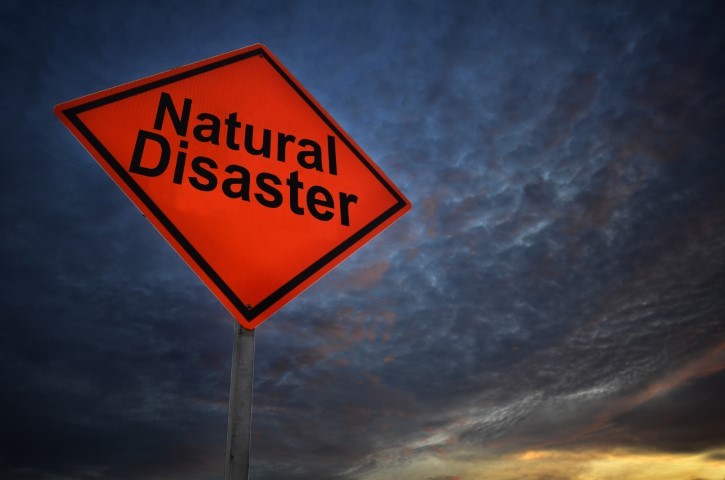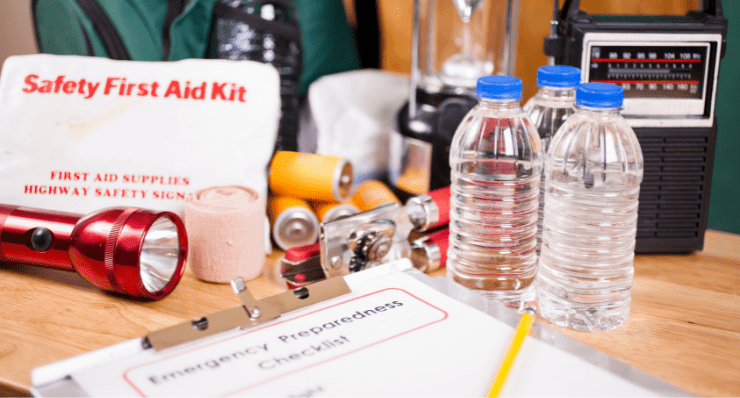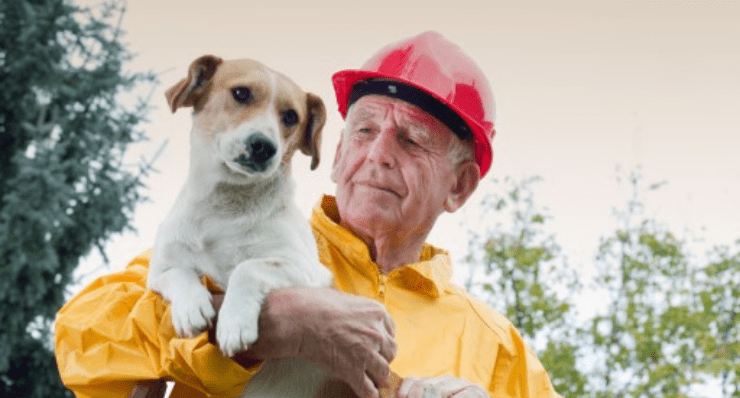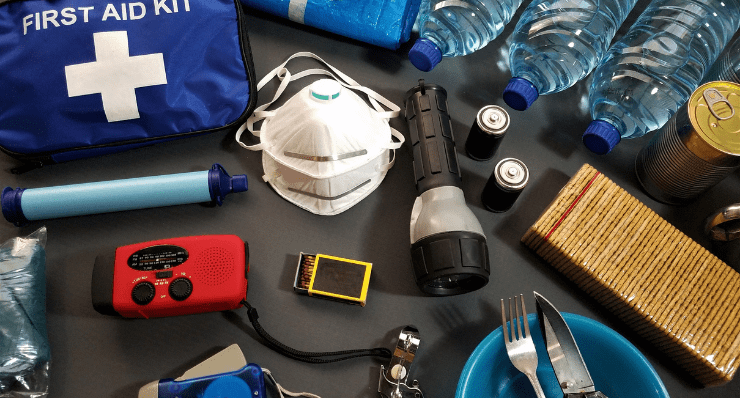
The thought of preparing for natural disasters generally does not top the list of things to do for homeowners. It’s a task that usually hovers on the “I’ll get to it list.” But the process of preparing for natural disasters is steadily gaining priority as damage from storms and other events make headlines across the country.
By definition, a natural disaster is classified as a major to a catastrophic event and is most often linked to weather or atmospheric changes. Natural disasters include wildfires, hurricanes, floods, tornadoes and earthquakes. The majority of natural disasters are weather-related and why there is an increased emphasis for homeowners to be prepared in advance to reduce the risk of damage and injuries.
How can we prepare for natural disasters?
The best way to prepare for a natural disaster is to have a plan that can be easily executed to keep you and your family members safe. A good rule of thumb is to think of everything needed prior, during and after the disaster. Gather everything and store it in a secure location.
A natural disaster often leaves a location without basic utility services, so it’s a good idea to plan alternative ways to keep warm if there is a loss of power, charge electronics and keep appliances like the refrigerator running as needed. There is no perfect timeline for when a natural disaster will occur. However, if there is an imminent threat of an emergency, you may not be permitted to travel out of the area so having a plan will be critical.
Checklist to Prepare for a Natural Disaster:
-
Make a plan
-
Designate an emergency contact number
-
Know your location
-
Keep an eye on the weather, news updates
-
Pay attention to emergency alerts advisories
Going about daily life and busy schedules may mean turning out things including the weather report, but be cautious because an unexpected change in the forecast can alter a routine day. It may be too late to evacuate or gather certain supplies. Resources like ReadyNC provide tips for communicating during a natural disaster and other topics.

What are the four stages of disaster preparedness?
A natural disaster is the last thing anyone wants to think about; however, dealing with types of emergencies can be less stressful if you prepare ahead of time.
As designed by the Federal Emergency Management Agency or FEMA, disaster preparedness is divided into distinct phases.
Preparedness stages are:
-
Mitigation – steps to reduce the impact
-
Preparedness – planning, gathering equipment & supplies
-
Response – actions immediately following the event
-
Recovery – rebuild, restore
The phases are designed to help make the overall process more manageable when planning. Currently, prevention, in some instances, is included as one of the stages of disaster preparedness. The prevention stage focuses on those things that can be done to avoid the natural disaster altogether such as a fire or other damage.
What are the most common natural disasters in North Carolina?
The diverse landscape of North Carolina stretches approximately 500 miles from the Outer Banks to the mountains in the western part of the state. According to ReadyNC, North Carolina has experienced various natural disasters statewide.
Common natural disasters in North Carolina are:
-
Hurricanes
-
Tornadoes
-
Lightning/Thunderstorms
-
Snowstorms
-
Ice storms
The aftermath of damage from a hurricane or winter storm in North Carolina typically has a broader reach than the impact area. Hurricane season on the Atlantic Coast is from June 1st to November 30th each year, and the season peaks between mid-August to late October. Winter storms include snow and ice storms and occur when temperatures dip to very low levels. The high winds associated with both storms cause power outages that last from several hours to days or weeks, depending on the event’s severity.
Tornadoes, considered quick and violent storms, often occur with little or no warning and can leave a path of destruction for miles. The peak season for tornadoes in North Carolina is between March and May. As with hurricanes and winter storms, it is common to have power outages following a tornado along with other damage. It is important to know the difference between whether a tornado watch and a tornado warning is issued in your area in order to seek shelter accordingly.
As with all-natural disasters, having a plan in place is a critical step to being prepared.

What are the main components of a disaster plan?
The basics of a disaster plan will involve creating a road map or action steps to take before a natural disaster. Working on a disaster plan means thinking about what you and your family will do before, during, and in the event's immediate aftermath. In addition, the recovery process must also be considered in the overall plan.
An effective disaster plan should cover these main components:
-
Checklist of what needs to be done to prepare home
-
Emergency contact plan
-
Document property for insurance
-
Supplies
Ready, a national public service campaign, provides informational guides aimed at preparing for natural disasters and other emergencies.
Why should we be prepared for natural disasters?
The fear of the unknown is often a stressful situation for anyone to face. However, the ability to plan ahead for a natural disaster often helps provide a sense of calm control, channeling the anxiety to remain safe and secure.
It is difficult to predict when a natural disaster will impact an area in some cases. Think of a natural disaster plan sort of like insurance, designed to diminish the risk of physical harm. The overall intent is to focus on what needs to be done in order to maximize efforts and time.
Items to consider in planning for a natural disaster include:
-
Do you have enough cash on hand?
-
Is it safe to shelter in place?
-
What is the evacuation route?
-
Will there be enough fuel for vehicles?
-
How to obtain medications?
-
Who is on the list of emergency contacts?
Answering a series of questions about your basic needs such as medications, money, fuel, and shelter is the foundation of creating a natural disaster plan.
3 Things we need to prepare for in a natural disaster
As a homeowner, there are several things you will need to prepare for in a natural disaster that will make a difference in the recovery process.
-
Keep important documents in a safe and secure location. They will be needed in the aftermath, especially if any property damage is sustained during the event.
-
Ensure that insurance policies are up to date for property, vehicles and medical.
-
Consider purchasing a generator to keep appliances running as needed if power is lost.
What are 10 items in an emergency kit?
Putting together an emergency kit is necessary and should be taken seriously to consider what you and your family will need before, during, and after a natural disaster. While every emergency kit can be somewhat unique depending on many factors, this is not about loading up on party snacks, alcoholic beverages and other non-essential gear. The purpose of an emergency kit is survival.
The American Red Cross advises that an emergency kit should be stored in an easy-to-carry bag or case that can be quickly retrieved if needed while sheltering in place or packed for evacuation.
Recommended Items:
-
Water
-
Non-perishable food
-
Batteries
-
Radio
-
Portable charger (for cellphones & computers)
-
Toiletries
-
Cash
-
Medications
-
Emergency contact list
-
Work gloves & tools
Additional items in an emergency kit can range from a manual can opener, first aid kit, masks, matches, and candles, to name a few. Remember, the point is to include those items that will be useful in case of a power outage, blocked roads or debris removal.

Is North Carolina safe from natural disasters?
It is hard to find any location, including North Carolina, that can be labeled safe from natural disasters. Although natural disasters can occur at any time, North Carolina faces an annual threat of hurricanes like much of the Atlantic coast. The Atlantic hurricane season runs from June 1st to Nov. 30th and storms making landfall in North Carolina can impact much of the state causing damage from flooding, high winds, or tornadoes. The risk of tornadoes can occur at any time but are often associated with thunderstorms during the summer months. The state is also prone to winter storms that can create a welcomed snow day or a dreaded ice event making it difficult to navigate the region.
NC Realtors covers why preparation for natural disasters in the state is essential for homeowners ahead of time rather than trying to figure things out and stay safe in the midst of an event.
Advance Planning is Key to Prepare for Natural Disasters
Homeownership translates into a list of responsibilities, including preparing for the risk of a natural disaster. It’s not a glamorous topic, but the expert brokers with Landmark Realty have a wealth of experience to share as they also call the region home. Trust their professional advice during your home search and gain some valuable tips to ease your anxieties about hurricanes or winter storms.
Contact any Landmark real estate broker to discover the great communities in the region. Choose from a condo/townhouse, featured estates, or land to build your dream home here in Western North Carolina.
Posted by Landmark Concierge on
Leave A Comment